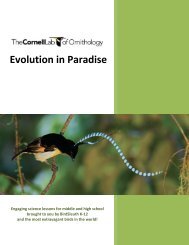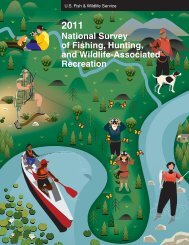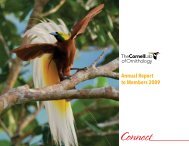AnnuAl RepoRt to membeRs | 2012 - Cornell Lab of Ornithology
AnnuAl RepoRt to membeRs | 2012 - Cornell Lab of Ornithology
AnnuAl RepoRt to membeRs | 2012 - Cornell Lab of Ornithology
You also want an ePaper? Increase the reach of your titles
YUMPU automatically turns print PDFs into web optimized ePapers that Google loves.
Birding can be a powerful force for understanding and protecting birdsSCIENCEA Continuous Continental Winter Bird SurveyeBird Illuminates Climate-Change ShiftsStudies examining changes in the arrival dates <strong>of</strong> migra<strong>to</strong>ry birds acrosstheir range have his<strong>to</strong>rically been constrained <strong>to</strong> small scales because formaldata were recorded only at specific reserves or research stations. Then cameeBird. In <strong>2012</strong>, University <strong>of</strong> North Carolina researcher Allen Hurlbert publisheda groundbreaking study showing how climate change is affecting birdmigration. Hurlbert examined millions <strong>of</strong> spring eBird observations for 18bird species from 2000 <strong>to</strong> 2010. By cross-referencing with weather data, hefound that bird species were shifting up their arrival dates almost a day forevery Celsius degree <strong>of</strong> increasing spring temperature. A few species, such asRed-eyed Vireo, Great Crested Flycatcher, and House Wren, shifted up theirarrival by as many as three <strong>to</strong> six days.“Volunteer citizen-scienceprograms such as ProjectFeederWatch and eBird haveproven extraordinarily important,even indispensable,for the success <strong>of</strong> modernbroad-scale avian ecologicalstudies.”—Benjamin Zuckerberg,Department <strong>of</strong> Forest andWildlife Ecology,University <strong>of</strong> WisconsinIn <strong>2012</strong> Project FeederWatch celebrated 25 yearswith more than 50,000 backyard birders reportingon feeder activity—and providing scientists with adeep dataset <strong>of</strong> bird abundance and ranges. <strong>Cornell</strong><strong>Lab</strong> researcher David Bonter examined FeederWatchdata from 1989 <strong>to</strong> 2006 <strong>to</strong> describe a markeddecline in Evening Grosbeaks, with a 27% decreasein flock size and 50% drop in sites reporting anygrosbeaks at all. The University <strong>of</strong> Wisconsin’s BenZuckerberg analyzed data collected between 1990and 2010 revealing that American Robins arrived 13days earlier in Wisconsin in spring, 1.5 days soonerfor every 1° C increase in winter temperatures.EveningGrosbeak byJudithBlakelyConservationImportant Bird Areas Near ChicagoConducting a proper bird inven<strong>to</strong>ry used <strong>to</strong> requirehundreds <strong>of</strong> hours <strong>of</strong> data processing, meaningthat only well-staffed operations could do it. Butwith eBird, the Chicago Wilderness Habitat Project,a small conservation group in northeastern Illinois,launched a bird survey with au<strong>to</strong>matic online datacompilation that involved thousands <strong>of</strong> Chicago-areabirders. Using data from its eBird portal, the groupprovided recommendations <strong>to</strong> land managers onprotecting key species and sensitive nesting areas.eBirders IMprove outlook for sagebrush birdsThe State <strong>of</strong> the Birds 2011 report, published by the <strong>Cornell</strong> <strong>Lab</strong> and partnersand delivered <strong>to</strong> the U.S. Department <strong>of</strong> the Interior, highlighted the importance<strong>of</strong> public lands as bird habitat. As a follow-up the <strong>Lab</strong> provided eBirdmodels <strong>to</strong> the Bureau <strong>of</strong> Land Management (BLM) showing distribution datafor sagebrush birds in the Intermountain West, including Brewer’s Sparrow,Sage Sparrow, Sage Thrasher, and Green-tailed Towhee. BLM policies willnow be adjusted <strong>to</strong> maximize benefits for sagebrush birds. “These models,based on tens <strong>of</strong> thousands <strong>of</strong> eBird observations, represent the best picturewe have <strong>of</strong> bird distributions in the West,” said <strong>Lab</strong> conservation scientistKen Rosenberg. “The eBird data opened the eyes <strong>of</strong> federal land managers <strong>to</strong>the tremendous opportunities for conserving birds on BLM lands.”Sage Thrasher by Chris Wood15






